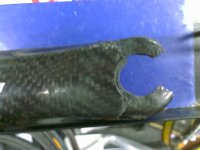Freddyflatfoot
1 kW
Couldn't seem to find any threads on this, so I thought I'd start one!
First, I'll describe the project, and then I'll welcome some meaningful discussion!
I want to build a light, nimble e-bike, Looking at a small, lightweight front hub motor, similar to, a Nano, with a LiFePo batt pack.
My project bike is a flat bar road bike, carbon fibre front forks, and carbon fibre rear seat stays. Rest is Al frame.
All the research I have done on carbon fibre forks so far, has indicated that carbin fobre is at least as strong as a steel fork, depending on how they are 'layered'.
I'm thinking that with a relatively lightweight motor, and 250 watts of power, that my current forks will suffice.
Does anyone have any experience with using carbon fibre on an e-bike?
I'm more interested in anyone that has had experience, rather than opinions. And if no-one has any experience, then I guess that would make me the guinea pig!
Rob
First, I'll describe the project, and then I'll welcome some meaningful discussion!
I want to build a light, nimble e-bike, Looking at a small, lightweight front hub motor, similar to, a Nano, with a LiFePo batt pack.
My project bike is a flat bar road bike, carbon fibre front forks, and carbon fibre rear seat stays. Rest is Al frame.
All the research I have done on carbon fibre forks so far, has indicated that carbin fobre is at least as strong as a steel fork, depending on how they are 'layered'.
I'm thinking that with a relatively lightweight motor, and 250 watts of power, that my current forks will suffice.
Does anyone have any experience with using carbon fibre on an e-bike?
I'm more interested in anyone that has had experience, rather than opinions. And if no-one has any experience, then I guess that would make me the guinea pig!
Rob




